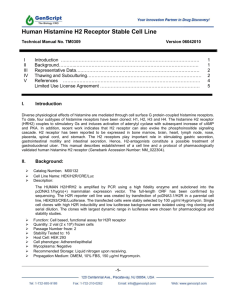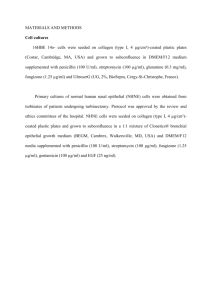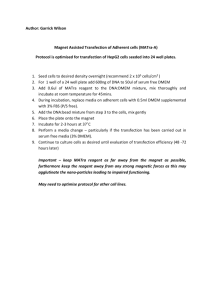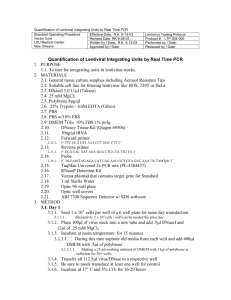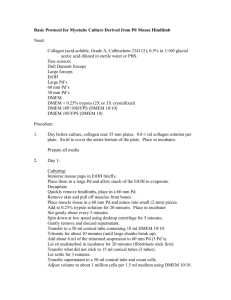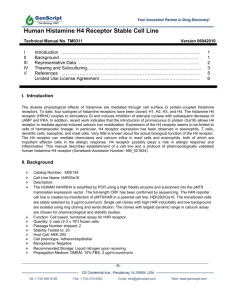Human Dopamine D1 Receptor Stable Cell Line
advertisement
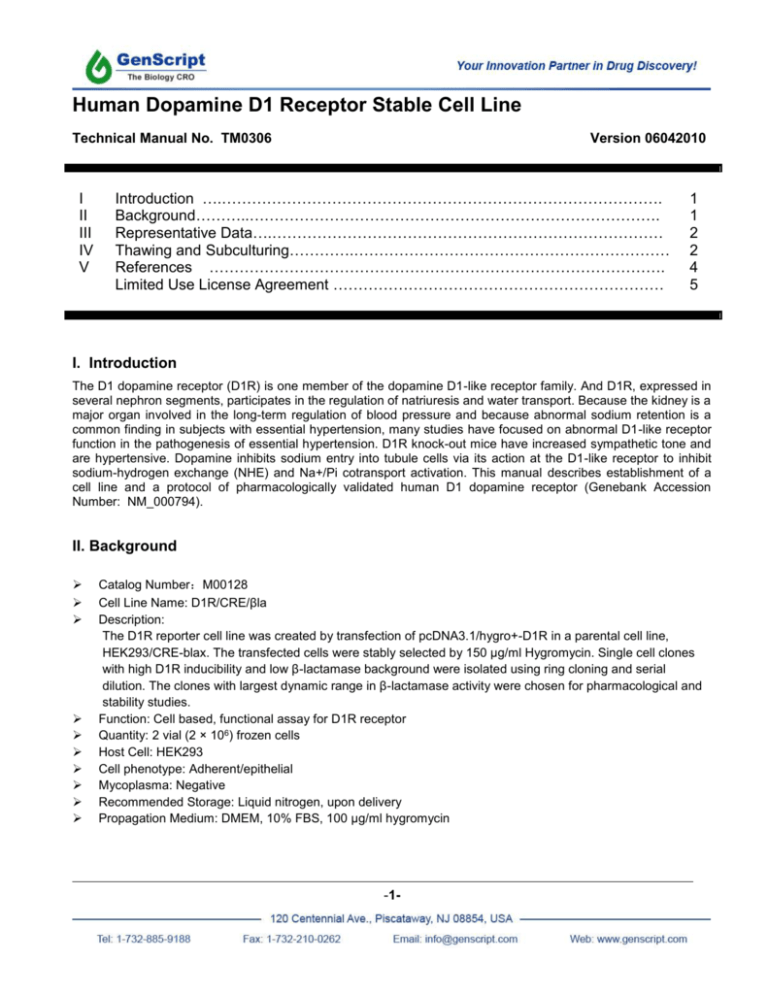
Human Dopamine D1 Receptor Stable Cell Line Technical Manual No. TM0306 I II III IV V Version 06042010 Introduction ….……………………………………………………………………………. Background………..………………………………………………………………………. Representative Data….…………………………………………………………………… Thawing and Subculturing………….……………………………………………………… References ………………………………………………………………………………. Limited Use License Agreement ………………………………………………………… 1 1 2 2 4 5 I. Introduction The D1 dopamine receptor (D1R) is one member of the dopamine D1-like receptor family. And D1R, expressed in several nephron segments, participates in the regulation of natriuresis and water transport. Because the kidney is a major organ involved in the long-term regulation of blood pressure and because abnormal sodium retention is a common finding in subjects with essential hypertension, many studies have focused on abnormal D1-like receptor function in the pathogenesis of essential hypertension. D1R knock-out mice have increased sympathetic tone and are hypertensive. Dopamine inhibits sodium entry into tubule cells via its action at the D1-like receptor to inhibit sodium-hydrogen exchange (NHE) and Na+/Pi cotransport activation. This manual describes establishment of a cell line and a protocol of pharmacologically validated human D1 dopamine receptor (Genebank Accession Number: NM_000794). II. Background Catalog Number:M00128 Cell Line Name: D1R/CRE/βla Description: The D1R reporter cell line was created by transfection of pcDNA3.1/hygro+-D1R in a parental cell line, HEK293/CRE-blax. The transfected cells were stably selected by 150 μg/ml Hygromycin. Single cell clones with high D1R inducibility and low β-lactamase background were isolated using ring cloning and serial dilution. The clones with largest dynamic range in β-lactamase activity were chosen for pharmacological and stability studies. Function: Cell based, functional assay for D1R receptor Quantity: 2 vial (2 × 106) frozen cells Host Cell: HEK293 Cell phenotype: Adherent/epithelial Mycoplasma: Negative Recommended Storage: Liquid nitrogen, upon delivery Propagation Medium: DMEM, 10% FBS, 100 μg/ml hygromycin -1- III. Representative Data 1. 2. 3. 4. 5. 6. 7. 8. 9. Seed 25,000 cells per well in Growth Medium (100 μl per well) into 96-well tissue culture treated blackwall, clear-bottom plates after trypsinization. Prepare some wells with medium alone (no cells) to use for determining plate background. Culture cells in 5% CO2 at 37C. Allow cells to reach ≈90% confluence. 12-24 hours before the assay, replace Growth Medium with 100 μl/well serum-free DMEM. Be careful not to disturb the cells. Prepare ligand solution in serum-free DMEM (10X). Add 10 μl of 10X ligand solution to wells for stimulation and 10 μl of serum-free DMEM per well for nonstimulated control. Incubate cells in 5% CO2 at 37°C for 5-6 hours. Load cells with 2 μM CCF4/AM as described in CCF4 Loading Protocol. Incubate the plate at room temperature for 60-120 min without shaking. Read with Analyst HT plate reader or similar fluorescence plate reader. IV. Thawing and Subculturing Cell Culture Conditions Complete Culture Medium: DMEM: 90%, FBS: 10%, L-glutamine 2.0 mM, Amp 100 μg/ml, Strep 100 μg/ml, Hygromycin 100 μg/ml Serum-free DMEM: Same as above but minus FBS, 0.1% BSA Freezing Medium: Complete culture medium plus 20% FBS and 10% DMSO -2- Thawing Cells: 1. 2. 3. Quickly thaw frozen cells in a 37°C water bath with a continuous agitation. Using a 1 ml pipette, slowly pipet the cells up and down 5 times and add, drop by drop, to a 15 ml centrifuge tube containing 5 ml of fresh prewarmed complete DMEM medium. Then centrifuge at 1,000 rpm for 5 minutes. Discard the supernatant medium and resuspend the cell pellet in 5 ml of fresh prewarmed complete DMEM medium. Transfer cells to a T25 flask and incubate at 37°C with 5% CO 2 until the cells reach >90% confluence. The recovery rate for frozen cells is usually 90% or above. Subculturing: When the cells reach confluence, they need split. This cell line is normally split twice weekly at 1:8 to 1:15 dilutions. 1. Carefully aspirate all the media, gently rinse the cell layer with appropriate amount of 0.2% trypsinEDTA, and aspirate it off. 2. Wait for about 1-3 minutes; dislodge the cells by gently tapping the sides of flask or dish. 3. Resuspend cells with appropriate amount of complete DMEM medium, and split cells as desired. Changing Medium: This is normally done every other day. 1. 2. Gently aspirate off medium. Transfer fresh warm complete DMEM medium (37°C) into a flask (5 ml for T25 and 10 ml for T75) Freezing Cells: 1. 2. 3. Repeat steps 1-3 of subculturing section. Centrifuge down the cells at 1,000 rpm for 5 min. Aspirate off the supernatant and resuspend the cells in fresh freezing medium at a density of 2-3 × 106 cells/ml. Add 1 ml cells per Cryogenic Vial. 4. Put the Cryogenic Vial of cells into Cryo Freezing Container, followed by transferring the container into -80°C and staying overnight. 5. Transfer Cryogenic Vial into liquid nitrogen (-196°C). Reagents & Consumables: 1. 2. 3. 4. 5. 6. 7. 8. 9. 10. 11. 12. 13. DMEM: Dulbecco’s Modified Eagle Medium powder, high glucose (Gibco BRL, Cat #12100-046) FBS: Fetal Bovine Serum (Hyclone, Cat #CH30160.03) L-Glutamine: 200 mM (Gibco BRL, Cat # 25030-081) Ampicillin: 50 mg/ml (Sigma A-9518) Streptomycin Sulfate: 50 mg/ml (Gibco BRL, Cat # 11860-038) Hygromycin B in PBS, 50 mg/ml (Invitrogen, Cat #10687-010) Trypsin: 1:250 rom Bovine Pancreas (Gibco BRL, Cat # 27250016) DMSO: dimethyl sulphoxide (Sigma, Cat #D8418) Hepes: Sigma Cat #H-3375 CCF4: (Invitrogen, Cat #K1096) Dopamine: (Sigma Cat #H8502) Venor@GeM Mycoplasma Detection kit: Minerva Biolabs Cat #11-1050 96 Well Plate: Costar, Cat# 3603, Blackwall/clear bottom, Polystyrene, sterilized. Media and Solutions: 1. PBS (for preparation of 500 ml) 1) KCl: 2) KH2PO4: 3) NaCl: 4) Na2HPO4.12H2O: 0.1 g 0.1 g 4.0 g 1.4425 g -3- Dissolve the above components in double-distilled water (ddH2O) and adjust pH to 7.4 with 0.1 N NaOH. Add ddH2O to the final volume of 500 ml. Autoclave and store at 4°C. 2. Trypsin-EDTA (for preparation of 100 ml) 1) Trypsin: 0.25 g 2) 2%EDTA: 2 ml 3) PBS: 98 ml Dissolve trypsin in 2%EDTA and PBS completely; sterilize the solution by passing through a 0.20 μm membrane filter; store at 4°C. 3. Culture medium (for preparation of 1 L) 1) Measure out 950 ml distilled water to dissolve the media components with gentle stirring until the solution becomes clear. 2) Add NaHCO3 3.7 g for high glucose DMEM 3) Adjust pH of medium to 0.2-0.3 below the desired final working pH (using 1 N NaOH or 1 N HCL is recommended). Add slowly with stirring. 4) Dilute to 1 liter with ddH2O. 5) Sterilize the medium immediately using the method of membrane filtration. Store at 4°C 4. Ampicillin/Streptomycin 50 mg/ml Dissolve 1 g Ampicillin or Streptomycin in 20 ml ddH2O and sterilize the solution by membrane filtration using 0.20 μm filter. Aliquot and store at 4°C for short-term conservation and -20°C for long term conservation. V. References 1. 2. 3. 4. Hussain, T. & Lokhandwala, M. F. Renal dopamine receptor function in hypertension. Hypertension 32, 187-97 (1998). Jose, P. A., Eisner, G. M. & Felder, R. A. Dopamine receptor-coupling defect in hypertension. Curr Hypertens Rep 4, 237-44 (2002). Felder, C. C., Campbell, T., Albrecht, F. & Jose, P. A. Dopamine inhibits Na(+)-H+ exchanger activity in renal BBMV by stimulation of adenylate cyclase. Am J Physiol 259, F297-303 (1990). Perrichot, R. et al. Locally formed dopamine modulates renal Na-Pi co-transport through DA1 and DA2 receptors. Biochem J 312 (Pt 2), 433-7 (1995). GenScript Corporation 120 Centennial Ave., Piscataway, NJ 08854 Tel: 732-885-9188, 732-885-9688 Fax: 732-210-0262, 732-885-5878 Email: info@genscript.com Web: http://www.genscript.com For Research Use Only. -4- Limited Use License Agreement This is a legal agreement between you (Licensee) and GenScript USA Inc. governing use of GenScript's stable cell line products and protocols provided to licensee. By purchasing and using the stable cell line, the buyer agrees to comply with the following terms and conditions of this label license and recognizes and agrees to such restrictions: 1) 2) 3) The products are not transferable and will be used at the site where they were purchased. Transfer to another site owned by buyer will be permitted only upon written request by buyer followed by subsequent written approval by GenScript. The purchaser cannot sell or otherwise transfer (a) this product (b) its components or (c) materials made using this product or its components to a third party. The products sold by GenScript are for laboratory and animal research purposes only. The products are not to be used on humans, for consumption, or for any unlawful uses. GenScript USA Inc. will not assert against the buyer a claim of infringement of patents owned or controlled by GenScript USA Inc. and claiming this product based upon the manufacture, use or sale of a clinical diagnostic, therapeutic and vaccine, or prophylactic product developed in research by the buyer in which this product or its components has been employed, provided that neither this product nor any of its components was used in the manufacture of such product. For information on the use of this product for other purposes, contact Marketing Department, GenScript USA Inc., 120 Centennial Avenue, Piscataway, New Jersey 08840, U.S.A. Phone: 1-732885-9188. Fax: 1-732-210-0262. Email: marketing@genscript.com. -5-


